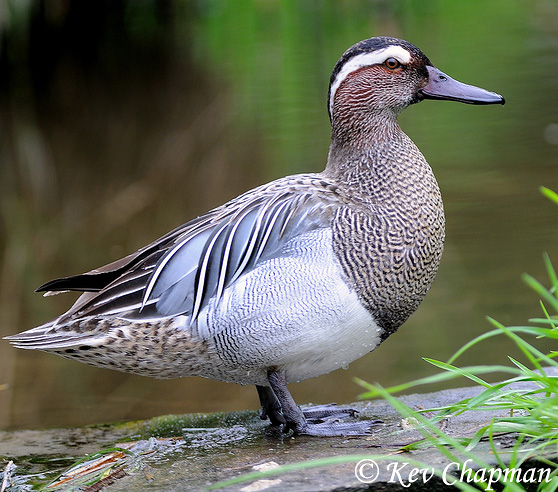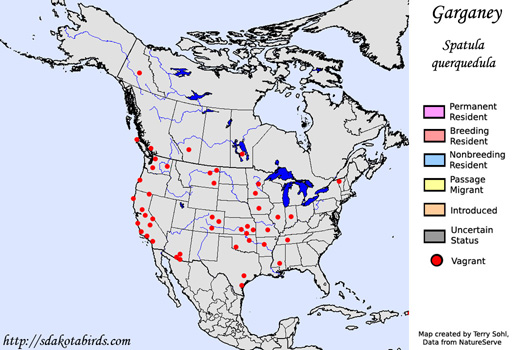Garganey
Spatula querquedula
| Length: 16 inches | Wingspan: 24 inches | Seasonality: Non-resident in South Dakota |
| ID Keys: Males with bold white stripe on head, dark barred breast, lighter barred flanks, slate grayish-blue secondaries | ||
 The
Garganey is a widespread dabbling duck of Europe and Asia. They are
long-distance migrants in Eurasia, a trait which may contribute to the
occasional sighting of the species in North America, where sightings have
occurred in scattered locations across the continent. While the plumage is
very different, Garganey are very similar ecologically to the
Northern Shoveler of North America.
The
Garganey is a widespread dabbling duck of Europe and Asia. They are
long-distance migrants in Eurasia, a trait which may contribute to the
occasional sighting of the species in North America, where sightings have
occurred in scattered locations across the continent. While the plumage is
very different, Garganey are very similar ecologically to the
Northern Shoveler of North America.
Habitat: During the summer breeding season, they are found in wetland habitats and shallow ponds and lakes, particularly those with an abundance of aquatic vegetation. They can also be found in flooded fields (and other flooded areas), and wet meadows. During migration and in the winter, they typically utilize similar habitat, but will inhabit a greater variety of aquatic habitats, including occasional stops and stays on brackish or coastal saltwater environments.
Diet: Omnivorous, feeding on a variety of food items. Animal matter makes up a large portion of the diet during the breeding season, with food items including aquatic insects and their larvae, small crustaceans and mollusks, leeches, small fish, and tadpoles and tiny amphibians. They also feed on significant amounts of plant matter, especially in the winter, with food items including the seeds, roots, leaves, buds, and stems of a variety of aquatic plants and sometimes terrestrial grasses.
Behavior: Ecologically behaves very similar to North America's Northern Shoveler. They dabble at the water's surface, filtering water through comb-like structures in the beak to strain out food items.
Nesting: Uses grassy areas near water for breeding, with the nest consisting of a depression on the ground or in herbaceous vegetation. Nesting occurs either as isolated pairs or small, loose groups of breeding birds.
Migration: Strongly migratory. Garganey nest in large portions of Europe and Asia. They move to Africa, India, southeastern Asia, and Indonesia for the winter.
Interactive eBird Map: Click here to access an interactive eBird map of Garganey sightings
Similar Species: Males are distinctive in breeding plumage. In non-breeding plumage, they are similar to the Blue-winged Teal., but facial patterns in the plumage are distinct.
Conservation Status: There are currently no perceived major threats to Garganey populations, and the IUCN cites it as a species of "Least Concern".
Further Information: 1) BirdLife International - Garganey
2) BirdWeb.org - Garganey
3) IUCN Red List - Garganey
Photo Information: Photo taken by Kev Chapman - Llicensed under Creative Commons Attribution 2.0 Generic License
| Click below for a higher-resolution map |
 |
| South Dakota Status: Non-resident in South Dakota |
Additional Garganey Photos (coming soon!!)
